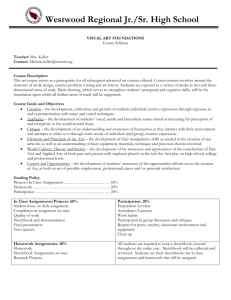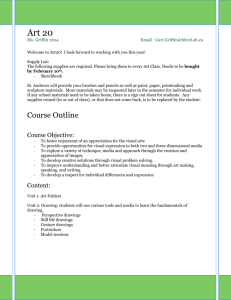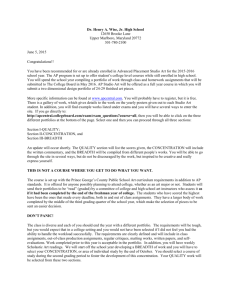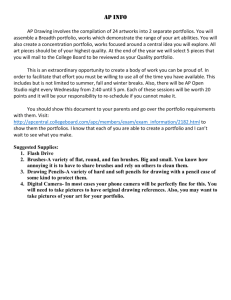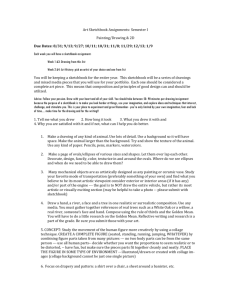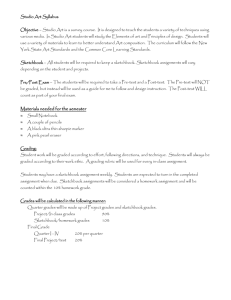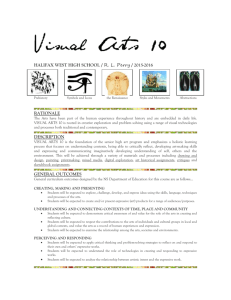SKETCHBOOK IMAGE BANK
advertisement
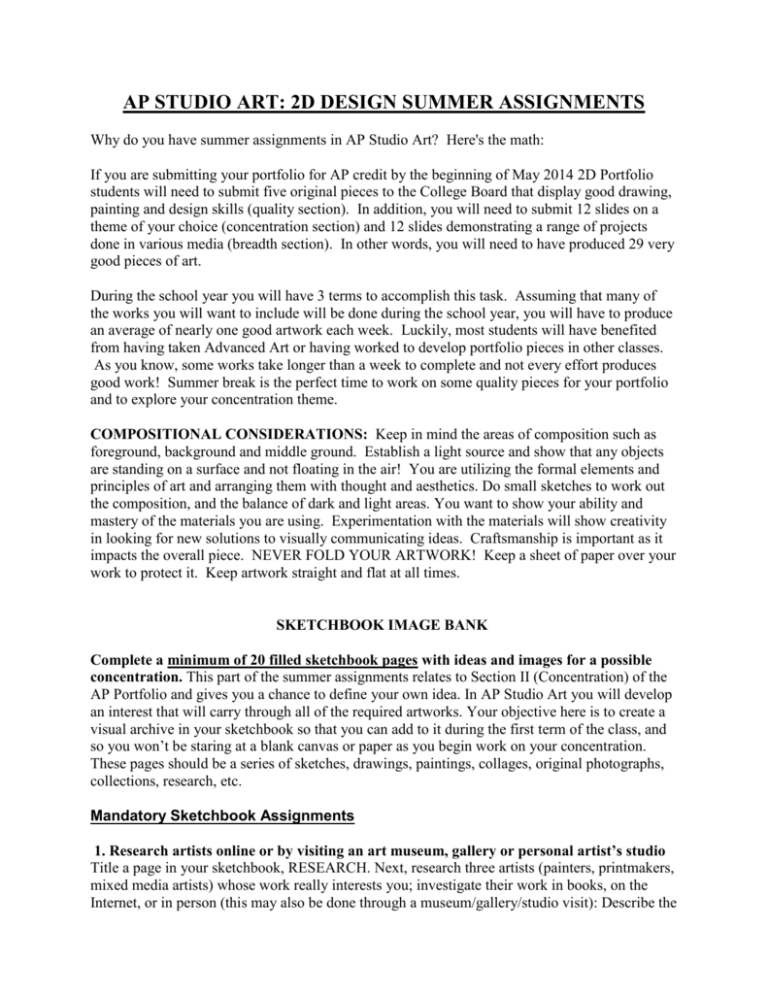
AP STUDIO ART: 2D DESIGN SUMMER ASSIGNMENTS Why do you have summer assignments in AP Studio Art? Here's the math: If you are submitting your portfolio for AP credit by the beginning of May 2014 2D Portfolio students will need to submit five original pieces to the College Board that display good drawing, painting and design skills (quality section). In addition, you will need to submit 12 slides on a theme of your choice (concentration section) and 12 slides demonstrating a range of projects done in various media (breadth section). In other words, you will need to have produced 29 very good pieces of art. During the school year you will have 3 terms to accomplish this task. Assuming that many of the works you will want to include will be done during the school year, you will have to produce an average of nearly one good artwork each week. Luckily, most students will have benefited from having taken Advanced Art or having worked to develop portfolio pieces in other classes. As you know, some works take longer than a week to complete and not every effort produces good work! Summer break is the perfect time to work on some quality pieces for your portfolio and to explore your concentration theme. COMPOSITIONAL CONSIDERATIONS: Keep in mind the areas of composition such as foreground, background and middle ground. Establish a light source and show that any objects are standing on a surface and not floating in the air! You are utilizing the formal elements and principles of art and arranging them with thought and aesthetics. Do small sketches to work out the composition, and the balance of dark and light areas. You want to show your ability and mastery of the materials you are using. Experimentation with the materials will show creativity in looking for new solutions to visually communicating ideas. Craftsmanship is important as it impacts the overall piece. NEVER FOLD YOUR ARTWORK! Keep a sheet of paper over your work to protect it. Keep artwork straight and flat at all times. SKETCHBOOK IMAGE BANK Complete a minimum of 20 filled sketchbook pages with ideas and images for a possible concentration. This part of the summer assignments relates to Section II (Concentration) of the AP Portfolio and gives you a chance to define your own idea. In AP Studio Art you will develop an interest that will carry through all of the required artworks. Your objective here is to create a visual archive in your sketchbook so that you can add to it during the first term of the class, and so you won’t be staring at a blank canvas or paper as you begin work on your concentration. These pages should be a series of sketches, drawings, paintings, collages, original photographs, collections, research, etc. Mandatory Sketchbook Assignments 1. Research artists online or by visiting an art museum, gallery or personal artist’s studio Title a page in your sketchbook, RESEARCH. Next, research three artists (painters, printmakers, mixed media artists) whose work really interests you; investigate their work in books, on the Internet, or in person (this may also be done through a museum/gallery/studio visit): Describe the issues that they explore in their artwork in your sketchbook and document them with drawings and pasted-in photographs. You may choose any 2D artists who interest you, and a list is provided below for your convenience: Pablo Picasso, Roy Lichtenstein, Edward Degas, Robert Indiana, Ed Ruscha, David Bates, Ida Applebroog, Alice Neil, Elizabeth Murray, Elizabeth Peyton, David Park, Fairfield Porter, Barbara Krueger, Banksy, Andy Warhol, Julian Beever, Edward Degas, Helen Frankenthaler. 2. Work in a personal sketchbook/visual journal/altered book. This portion of the sketchbook will be graded on the depth and quality of thinking. Sketchbook: Spend time every day working in your sketchbook. Put the date on each page. Make it fun! Design the cover and allow for any and all spontaneous art activity. Keep it ―glued to your hip. Use this book to sketch, paint, doodle, collage, collect objects and take pictures to generate visual ideas and/or write journal entries, make critical and informed decisions about your progress and jot down your reflections on the outcome. Visual ideas are akin to written observations of events or situations in daily life that are intriguing and could be used for an area of further investigation. Draw and write at least one or more entries per day. Make sketches of these ideas, which may be further developed into formal drawings. Write about what you like or don’t like about a drawing. Write about your hopes for artwork, why you make art and what level of an artist you’d like to become. Write about what you’d like to say in your artwork or in a larger sense. Most of all draw, draw, draw from life! Sketchbook practice is an ongoing process that informs your decision making and helps you develop ideas for works. By the end of the summer you should have generated five possible ideas based off of your Sketchbook musings that could be the basis for your concentration portfolio. By the second week of November 19th you will submit a formal written proposal for your concentration portfolio, which will include a body of work of twelve or more 2D artworks. For each project do several sketches. Sketches can be in pencil or color pencil if final art will be in color. Sketches should work out essential design issues before you start the final project. These include: 1. Composition, arrangements of shapes and objects. 2. the range of values (darks and light areas). 3. If color is used, the basic color arrangements Study the work of other artists for ideas on placement, surface treatment, marks, mixing media, themes, installations, etc., but do not copy from the actual works. DRAW! DRAW! DRAW! Going on a trip? TAKE YOUR SKETCHBOOK!!! View student concentrations by going to the College Board Studio Art page at http://www.collegeboard.com/student/testing/ap/sub_studioart.html, Gather and review all your current work, including studies, other sketchbooks, scribbles, and finished pieces. Do you see any themes in your work thus far? What pieces prompt you to continue to develop an idea or a technique? In your sketchbook, begin forming answers to the following questions: a. What was your initial idea? b. How did your idea grow and develop? c. What are the next steps you might take to continue your investigation of this idea? Note: DON’T WORRY! By developing and recording these ideas in your sketchbook, you are not committing yourself to anything yet. There will be time for that in November. ART WORKS Three Finished Art Works: Complete 2 works of art from a-d, and all Mandatory assignments below: Choose Two: a. 3-Headed Self-Portrait from Observation. Develop a representational self-portrait using an interesting composition with at least three views of your head. Be sure to fill the picture plane – and no floating heads! Strive to tell the viewer something about yourself with this piece. b. Reflection from Observation. The reflection you render can be from either water or a shiny object. For example, a building and it’s reflection in a puddle, anything reflected from shiny objects-toaster, coffee pot, spoon, tanker truck, etc. (think full range of values, think multiple objects not just one pot…) c. Gridded Portrait Drawing. Create a portrait composition based on an invented grid. Each grid area contains an area of the face. See samples for ideas. Project Steps 9 “ x 12” 1. Take pictures of your face from three different angles 2. Use strong side light to create darks and lights 3. Do three sketches creating three possible grid patterns 4. Do final sketch of how you will place portions of photos. Create a center of interest according to the rule of thirds 5. Redraw grid on drawing paper 6. Draw in features in outline in pencil 7. Finish drawing in color pencil d. Dissection: Do a study of an object that you have taken apart. Arrange the parts on a surface with other objects related or not related and study the TEXTURAL qualities. Some ideas would be a mechanical object, a child’s toy, a girls makeup bag, your bin of art supplies, ingredients for a cooking recipe, a few apples or other fruit cut apart…anything where you are creating a still composition out of something that has been dissected or disassembled. This does not have to be boring! Put your own spin on it and MAKE IT FUN! Mandatory: a. Trial Concentration Piece: Develop one idea you have for your concentration into a finished work of art. This will give you a chance to see if the idea is interesting to you, and has the depth to develop over the next school year. You will finalize your concentration theme by the end of November. b. Self-Portrait: Arrange interesting side lighting and be sure to add a background or setting (no floating heads). Make use of dramatic lighting. Project Steps 1. Dramatic lighting with strong darks and lights 2. Original and unusual placement of face in picture format that integrates with the background. Using darks and lights or other elements in the background to create a unity. 3. On paper no larger that 18 x 24. but no smaller than approx. 9 x 12. Use pencil, charcoal, pastel, or other drawing media. 4. Don’t draw an isolated portrait in the middle of the page. c. Still life: Set up a still life with strong light source, near a window or with a side light. Possible objects: eggs on torn or crumpled paper, tin cans or glass jars, fruit on drapery, or raid the vegetable bin of the refrigerator. Be sure to compose the entire page Project steps 1. Set up still life with a minimum of 5 objects 2. Consider placement of objects. Group objects together to create pleasing balance where objects overlap each other so that there is a sense of unity of design. Consider unusual setup of objects 3. Light still life with a strong side light so that you see definite cast shadows. Light should create a dramatic effect. 4. Do small thumbnail sketch to decide on composition. Consider the negative space around objects. Make sure objects or not floating in space. The space around objects should make interesting shapes. 5. Draw still life on to larger paper. You can also take a photo of the still life and work from it. Work to achieve consistency of technique and quality craftsmanship 6. Drawing should be on paper at least 11 x 14 inches in size up to 16 x 20 inches. All projects submitted in portfolio cannot be larger that 18 x 24 including matting. You can decide on the specific size as long as it falls into these parameters. 7. Still life should have a full range of values from dark to light in order to create a dramatic effect. 8. Still life can be done in pencil, charcoal, charcoal pencil, or conte crayon. Make sure to include in your project: Strong lights and darks Side lighting (dramatic) Balanced grouping of objects At least 5 objects Don’t forget your planning tools! Gather reference images in your sketchbook, do compositional studies or thumbnail sketches, look at the work of other artists. Works should be a minimum of 9” x 12”, maximum of 18” x 24”. Choose any medium consistent with your AP portfolio criteria. Design 1. Create artworks that have a center of interest with other supporting shapes, areas objects etc. Put the center of interest off center but not at the edges of the paper 2. Create artwork that has a range of values from dark to light that provides a sense of strong contrast. Craftsmanship 1. Decide on an approach in applying the medium and use the same approach consistently throughout the project. Use media that you are comfortable with. Pencil or charcoal pencil is a good beginning choice. Use a quality drawing paper with a slightly textured surface. 2. Make sure your drawing is the most detailed and refined at the center of interest area. Creativity 1. Take your own photos in various configurations. Do several sketches to come up with an original idea. Do not use photos from magazines or internet. 2. Try to create an unusual approach. Try different points of view or angles. Project Assessment Design a. Balance created by using the rule of thirds for asymmetrical design according to the rule of thirds, the center of interest is placed at any point off center but not at the edge of the picture, with other supporting images or shapes. b. Shows a center of interest or focal point that has the most visual interest and contrast c. Over all design has range of values from dark to light. Craftsmanship a. Style or technique in which the piece is executed is consistent through out and brought to completion b. Detail must be most apparent at the center of interest Creativity a. Solution to the design problem is unique. The overall design and images sustain interest. b. Student takes their own photos or uses photos in a unique way c. Student doesn’t simple copy photos For All Summer Assignments: If it isn’t written in the description above, you don’t need permission to add or expand. Use your sketchbook to do planning for each work of art assignment you choose to do. Students are expected to supply their own materials for all summer assignments, but let us know before summer break if you need any assistance with this. I’ll be available on June 5th after school to help you gather materials to take home for the summer. Summer assignments (Art Works and Sketchbook Image Bank-20 pages) will constitute a significant portion of your first grade (25%). Art works should be "finished" pieces. We will critique the works during the first week of class. Rushed work is obvious and will receive a lower score. Your art works and 20 sketchbook pages are due the second day the AP Studio Art class meets in September. Start dropping things off in Room 237 the week prior to the start of school during our open studio art days on August 28th and 29th. If you have any questions about this summer work, please ask for clarification before you leave on summer break, or e-mail me fosterb@charlottenet.org. Go to www.edmodo.com create an account, enter the following group code “g41e2p” and log in. All assignments will be posted to this website. Students who wish to photograph their progress and get feedback from me throughout the summer can do so by e-mailing me a jpeg image, or posting it on our class website. During the summer months I will try to respond within a week. This handout is available on our class website should you misplace it. Have a great summer! Ms. Betsy Foster AP Studio Art Instructor Keep in Mind (from AP Central): If you submit work that makes use of photographs, published images, and/or other artists' works, you must show substantial and significant development beyond duplication. This may be demonstrated through manipulation of the formal qualities, design, and/or concept of the original work. It is unethical, constitutes plagiarism, and often violates copyright law to simply copy an image (even in another medium) that was made by someone else. *You must take your own photos. Artworks that copy photos from the internet or magazines will not be graded.

